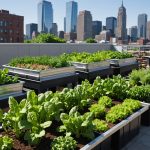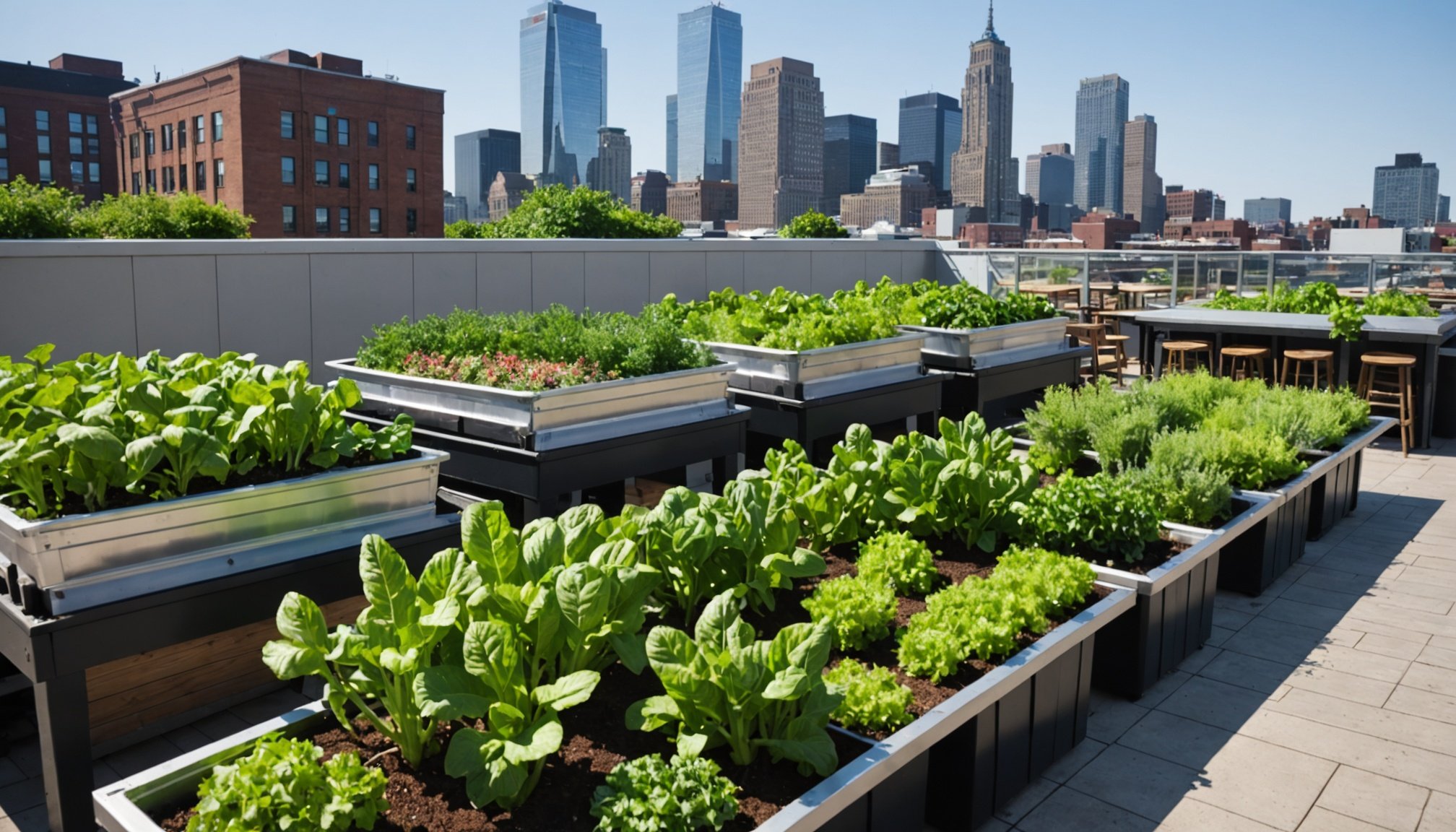Benefits of Rooftop Gardens for Restaurants
Rooftop gardens offer numerous advantages for restaurants aiming to embrace sustainability and eco-friendly practices. These gardens can significantly reduce heat absorption from buildings, contributing to lower energy costs and improving air quality. By incorporating rooftop gardens, restaurants can source fresh ingredients directly from their rooftops, ensuring a menu rich in quality and taste. This not only enhances the freshness of the dishes offered but also aligns with an eco-friendly ethos.
Moreover, adopting such sustainability measures can positively influence customer perception. Diners are increasingly valuing establishments that demonstrate commitment to environmental responsibilities. Implementing these eco-friendly practices can also boost branding efforts, positioning the restaurant as not just a place for exquisite dining but as a pioneer in the green movement.
In the same genre : Elevate your dining experience: expert tips for high-end restaurants to create a successful farm-to-table menu
Restaurants can cultivate an array of produce, from herbs to vegetables, ensuring a regular supply of fresh ingredients year-round. This approach not only ensures ingredient authenticity and quality but also reduces reliance on external suppliers, cutting transportation emissions and costs. Ultimately, rooftop gardens can become a trending topic for savvy restaurants, blending environmental benefits with enhanced culinary experiences.
Design Ideas for Rooftop Gardens
Creating the perfect rooftop garden design requires careful planning considering space optimization and aesthetics. Begin by assessing space available on the rooftop to make the most of its potential. Consider factors like weight capacity, sun exposure, and access to water sources to ensure a thriving garden. Each element plays a crucial role in determining the garden’s visual appeal and practicality.
Also to read : Elevate your dining experience: expert tips for high-end restaurants to create a successful farm-to-table menu
When it comes to space optimization, vertical gardening and container gardening offer innovative solutions. Vertical gardens capitalize on height, allowing more plants to grow in limited space. This method not only maximises green areas but also adds a stunning visual element to the garden design. Meanwhile, container gardening enables flexible arrangements, catering to diverse plant types and urban gardening needs.
Blending aesthetics with functionality is key to an appealing garden. Incorporate varied textures and colours to create a visually pleasing layout, while ensuring easy access to the plants for maintenance. Use design elements like trellises or decorative pots to enhance the garden’s charm.
Ultimately, a well-designed rooftop garden can transform a utilitarian space into an oasis, boosting both environmental benefits and the restaurant’s image.
Maintenance Tips for Rooftop Gardens
Maintaining a rooftop garden involves regular tasks that ensure plant health and garden vitality. Key activities include watering, weeding, and harvesting. Each task demands attention, particularly in urban environments where conditions may vary dramatically. Proper watering schedules are crucial, especially during dry spells, to maintain hydration for plants exposed to harsh rooftop conditions. Weeding keeps unwanted plants from competing for nutrients, essential for thriving vegetation.
Choosing the right plants is vital for effective rooftop garden maintenance. Opt for species resilient to sun exposure and wind typical of rooftops. Consider plants adapted to seasonal cycles to ensure year-round greenery. For example, selecting drought-tolerant herbs or hardy vegetables can minimise maintenance efforts while ensuring robust growth despite urban challenges.
Integrating technology can enhance garden management efficiency. Automated irrigation systems can alleviate manual watering duties, ensuring consistent moisture. Meanwhile, mobile apps can track plant health and suggest maintenance schedules based on real-time data. Leveraging these technological advancements aids in maintaining an impeccably managed garden. Not only does it support responsible care, but it also frees up time, allowing restaurant staff to focus on creating exceptional culinary experiences with the produce their rooftop gardens yield.
Case Studies of Successful Rooftop Gardens
Examining rooftop garden success stories provides valuable insights into implementing sustainable practices effectively. One notable example is the renowned Blue Hill restaurant in New York. Known for its innovative approach, Blue Hill seamlessly integrates rooftop gardening into its operations. The restaurant cultivates a variety of vegetables and herbs, showcasing the potential for locally sourced, fresh ingredients. This not only elevates the culinary experience but also enhances their sustainability credentials.
Another case study involves Germany’s Neni, which features an expansive rooftop garden at its Berlin location. By adopting sustainable practices, Neni has created a dining space that thrives on the produce grown on its roof. This approach supports the restaurant’s commitment to eco-friendliness and boosts its branding as a leader in urban agriculture.
These restaurant case studies highlight key strategies, such as investing in the right technology and selecting adaptable plant species, crucial for overcoming urban environmental challenges. Both establishments report positive customer engagement, linked directly to their green initiatives. From these successes, the lesson learned is clear: the thoughtful integration of rooftop gardens not only impacts environmental sustainability but also enhances customer loyalty and satisfaction.
Seasonal Planting Strategies
Understanding seasonal planting can revolutionise a restaurant’s ability to provide the freshest ingredients available. A well-planned planting calendar is essential for timing growth cycles, ensuring a consistent supply of produce. By cultivating seasonal versatility, restaurants can adjust their offerings according to nature’s rhythms, which delights customers seeking genuine freshness and taste.
Crop rotation emerges as a vital practice in sustainable gardening. It involves alternating crops in the same area to preserve soil nutrients and prevent pest accumulation. This method not only maintains soil health but also optimises yields, allowing restaurants to harvest robust produce repeatedly without depleting the soil.
Engaging creativity when using seasonal ingredients can lead to innovative menu development. Chefs can inspire diners with menus that reflect the uniqueness of each season, enriching the dining experience with distinct flavours. By sourcing directly from rooftop gardens, the use of ultra-fresh, seasonally appropriate ingredients shines through, further enhancing branding.
Beyond practical benefits, seasonal planting encapsulates a commitment to sustainability. It epitomises a harmonious blending of culinary art and environmental stewardship, creating a distinctive narrative that attracts eco-conscious diners and strengthens customer loyalty.
Integrating Rooftop Garden Ingredients into Menus
Exploring inventive ways to blend rooftop garden ingredients into your menu can elevate not only the dining experience but also your restaurant’s credibility. Embrace seasonal shifts by recalibrating your offerings to mirror nature’s rhythms. Implementing ingredient sourcing strategies ensures freshness and sustainability, resonating with eco-conscious diners. Curate a menu where the freshness bursts through, as directly from your rooftop to the plate.
Emphasize culinary creativity by crafting dishes that reflect the produce available, allowing the garden’s offerings to inspire the menu’s theme and reinforce your branding as a leader in sustainability. This approach fosters an intimate connection between the diners and the environment, as patrons savour meals abundant in flavours true to the region and season.
Transparency in sourcing builds trust, turning menu descriptions into narratives of fresh ingredients, fostering an authentic dining experience that sets your establishment apart. Showcasing the origin of the produce can be an engaging point of conversation, enhancing customer satisfaction. By intertwining the eco-friendly practices of rooftop gardens in your cuisine, your restaurant can stand as a pioneering advocate for sustainability, appealing deeply to the growing demand for green initiatives.
Cost Considerations for Rooftop Garden Implementation
When planning a rooftop garden implementation, understanding the balance between initial investment and long-term benefits is crucial. While the initial cost may appear substantial, encompassing materials, design, and engineering assessments, the potential savings and returns are noteworthy. Over time, these gardens contribute to reduced ingredient expenses, as they minimise reliance on external suppliers for fresh produce. Moreover, they can lead to lower energy costs due to their natural thermal insulating properties.
Exploring funding options and partnerships is essential to manage costs effectively. Restaurateurs can seek grants and incentives aimed at promoting sustainability and eco-friendly practices, which can markedly reduce upfront expenses. Partnering with local community groups or universities may also offer access to additional resources and expertise, fostering collaborative success.
Analyzing the return on investment (ROI) becomes paramount in understanding the true value rooftop gardens bring. Customer loyalty often sees an uptick as patrons support establishments championing green initiatives. By offering distinctive, sustainably sourced menus, restaurants position themselves as eco-conscious leaders, further enriching customer perception. Over time, the combined savings from fresh sourcing and bolstered customer engagement significantly enhance the restaurant’s financial and ethical standing.











